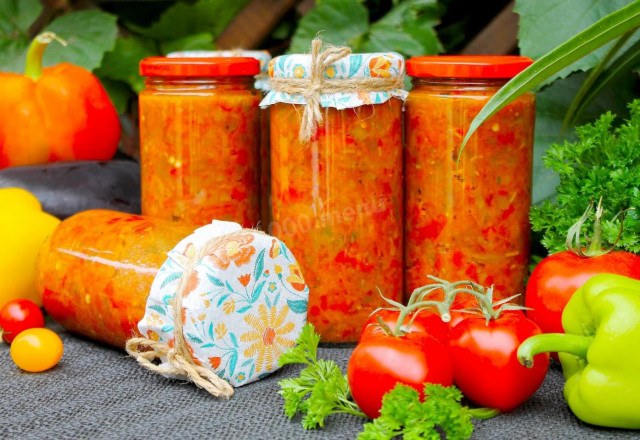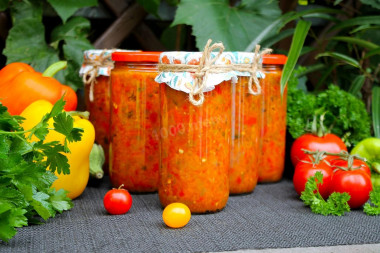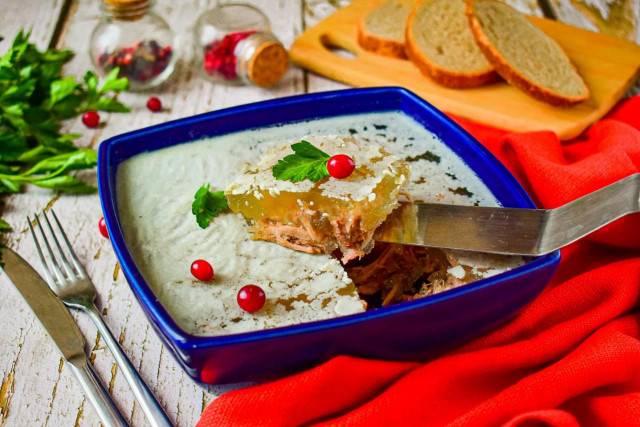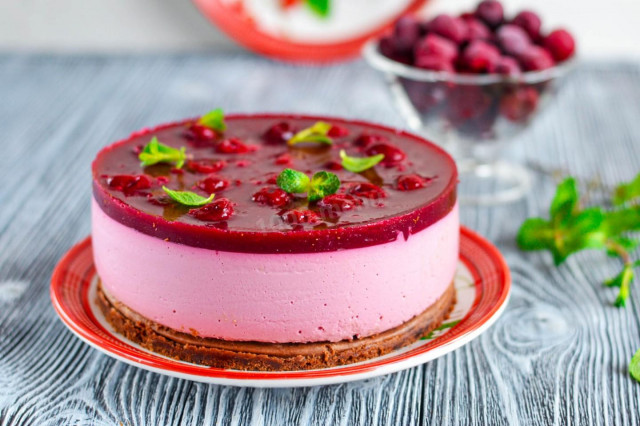Composition / ingredients
Step-by-step cooking
Step 1:
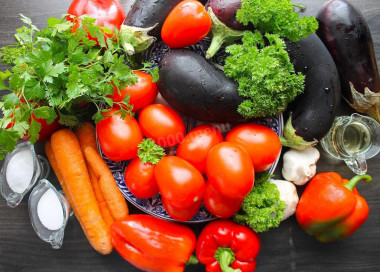
How to make a Bulgarian lutenitsa for the winter? Prepare all the products according to the list specified in the recipe. If you want to get a hot sauce, then include chili pepper in the ingredients. The amount of garlic can be increased or decreased at your request. So, wash all the vegetables and herbs and dry them with a kitchen towel.
Step 2:

Cover the baking tray with baking paper. Put the eggplant and bell peppers in one layer. Pour a small amount of vegetable or olive oil on top. Place in a preheated oven and bake at 180 degrees for about 40-60 minutes (the time and temperature may differ from those indicated in the recipe).
Step 3:
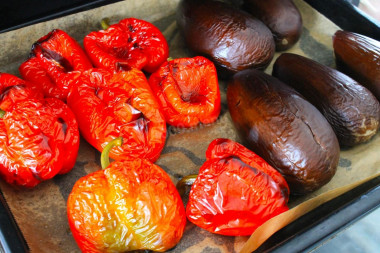
By the way, vegetables for lutenitsa can be baked on the grill, then you will get an amazing sauce with a light aroma of smoke. When the peppers and eggplants are slightly charred, and the peel becomes slightly burnt, you can proceed to the next step.
Step 4:
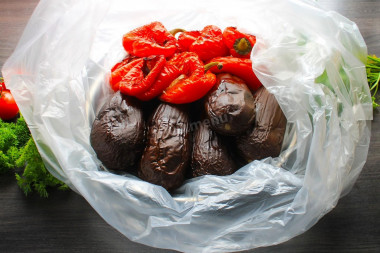
Take the vegetables out of the oven and put them in a plastic bag.
Step 5:

Tie the bag and leave the eggplants with peppers in this way for an hour or two. After the vegetables lie in the bag, they can easily be peeled off.
Step 6:
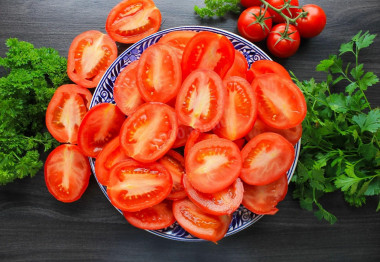
Cut tomatoes in half or quarters. If necessary, cut off the attachment points of the peduncle. Pass the tomatoes through a meat grinder or puree with a blender.
Step 7:

Put the tomatoes in a saucepan, put them on the stove. Bring to a boil, then reduce the flame to medium and cook the tomatoes for about 20 minutes.
Step 8:
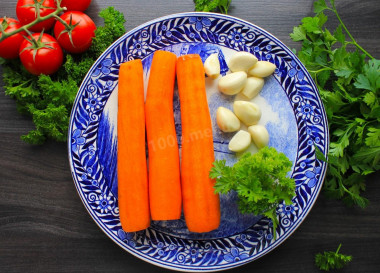
And at this time peel the carrots and garlic. Grate the carrots on a fine grater.
Step 9:

Heat the vegetable oil in a frying pan, add the carrots and fry for about 15 minutes over medium heat. Do not forget to mix from time to time so that nothing burns.
Step 10:
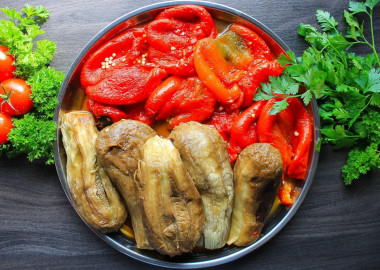
Remove the skin from the cooled eggplants and peppers. Remove the core with seeds from the peppers.
Step 11:

Chop the vegetables into small cubes.
Step 12:

Put eggplants, peppers, fried carrots and finely chopped garlic in a saucepan with tomato puree. At this stage, add the chili pepper if you are using it. Put the pan on the stove. Bring to a boil over high heat, then reduce the flame and cook for about 30 minutes, stirring occasionally.
Step 13:
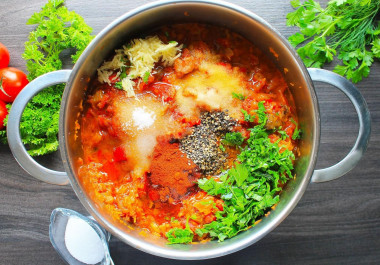
Add salt, sugar, butter, ground black pepper, paprika and finely chopped parsley to all the ingredients. Boil everything together for about 10 more minutes. Pour in the vinegar, leave for 2 minutes. Taste it and add the missing component if necessary (I slightly increased the amount of salt).
Step 14:
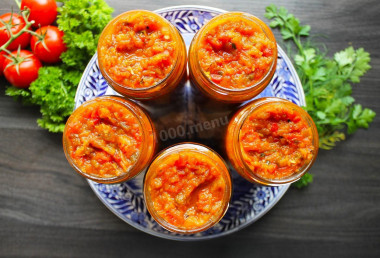
Sterilize jars and lids by any method available to you. You can do this in the oven, in the microwave or in a water bath. Arrange the lutenitsa in sterile jars, close the lids and send it upside down under a warm blanket. Leave it to cool completely, then put it in a dark, cool place for storage.
Step 15:
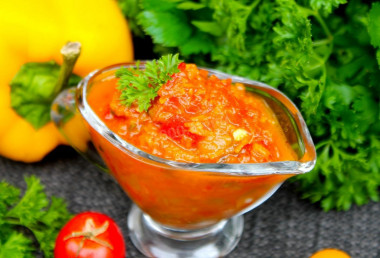
Amazingly delicious vegetable sauce is ready!
Lutenitsa - sauce and appetizer at the same time. From the specified number of products, I got about 1.8 liters of the finished product.
Bon appetit!
How to calculate the number of cans, why banks explode and how to avoid it, as well as secrets and life hacks, read the article about preparations for the winter.
Since the degree of salinity, sweetness, bitterness, sharpness, acid, burning is individual for everyone, always add spices, spices and seasonings, focusing on your taste! If you put some of the seasonings for the first time, then keep in mind that there are spices that it is especially important not to shift (for example, chili pepper).
Use oil with a high smoking temperature for frying! Any oils are useful only until a certain temperature is reached - the point of smoking, at which the oil begins to burn and toxic substances, including carcinogens, are formed in it.
Unrefined oils, with rare exceptions, have a low smoking point. There are a lot of unfiltered organic particles in them, which quickly begin to burn.
Refined oils are more resistant to heating, and their smoking point is higher. If you are going to cook food in the oven, on a frying pan or grill, make sure that you use oil with a high smoking point. The most common of the oils with a high smoking point: refined varieties of sunflower, olive and grape.
Caloric content of the products possible in the composition of the dish
- Tomatoes - 23 kcal/100g
- Sweet pepper - 27 kcal/100g
- Carrots - 33 kcal/100g
- Dried carrots - 275 kcal/100g
- Boiled carrots - 25 kcal/100g
- Eggplant - 24 kcal/100g
- Garlic - 143 kcal/100g
- Granulated sugar - 398 kcal/100g
- Sugar - 398 kcal/100g
- Wine vinegar (3%) - 9 kcal/100g
- Vinegar 9% - 11 kcal/100g
- Balsamic vinegar - 88 kcal/100g
- Apple vinegar - 14 kcal/100g
- Vinegar - 11 kcal/100g
- Vegetable oil - 873 kcal/100g
- Salt - 0 kcal/100g
- Paprika - 289 kcal/100g
- A mixture of ground peppers - 255 kcal/100g

